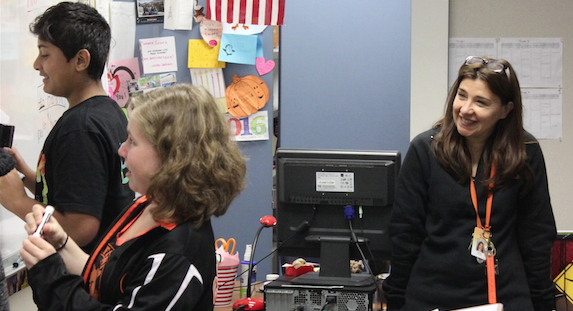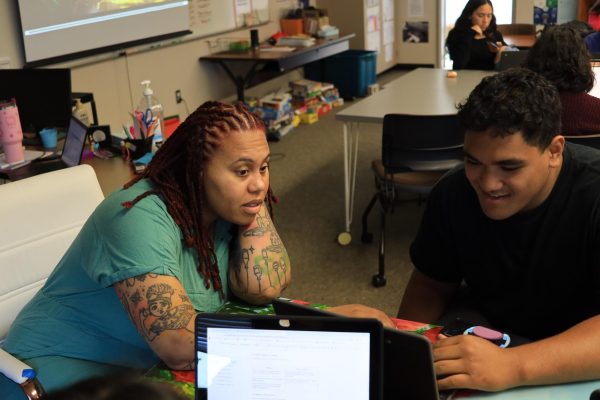Teachers embrace more than country’s language
Students study culture in language classes

French teacher Madame Colard helps freshmen students Rhys Cramer and Ish Kaatar learn common French slang terms in class to immerse students in French Culture.
Learning a completely new language can be extremely difficult and daunting for many students.
But at Cal High, foreign language teachers do more than just teach students Spanish, French, and Chinese.
The foreign language teachers on campus also showcase the cultures of the countries that speak these languages.
“You can’t learn language in isolation from the people who speak it because language is reflected in culture and culture is reflected in the language,” said French teacher Patricia Goldin.
Students who walk into a regular academic teacher’s classroom may see projects that students have produced, informational posters on walls, and family pictures covering the walls around their desk.
The foreign language teachers have all those things and much more.
Their classrooms also incorporate the culture of the language they are teaching in multiple different ways.
For example, Spanish teachers may have sombreros hanging in their classrooms, French teachers may have pictures of the Eiffel Tower, and the Chinese teacher may display traditional calligraphy on the walls.
The AP Language and Culture courses provide additional education about the culture in the curriculum.
Goldin branches off from six cultural themes that enhance the learning experience. Themes include world challenges, family and community, contemporary life, science and technology, aesthetics, and personal and public identities.
Goldin’s French IV class sometimes gets to eat French breakfasts in class, too.
Homework assignments may include researching the culture on their own as well.
“The students seem to love learning about culture, maybe even more than the language itself,” Goldin said.
Wen-fang Wang, who teaches the Chinese classes, educates her students on the culture in similar yet slightly different ways.
Wang’s cultural teachings are often embedded into the language lessons. Occasionally the students are able to bring in ingredients to make various Chinese dishes in class.
As many students may know, Chinese New Year was not only celebrated inside of the Chinese classrooms this year, but all around the school.
Wang’s students practiced Chinese calligraphy by writing lucky words on red paper, a tradition in the Chinese culture during the New Year.
Some were brought home and the majority of others were hanged up to share the luck around the school.
“If students learn the culture it will make them learn the language better,” said Wang. “The students love to learn about the culture. I’d say it is their favorite part.”
Other student activities include learning songs, dances, tai chi, and playing traditional games.
“She tried to give us a Chinese experience,” said sophomore Isabella Ng.
Ng also mentioned that on Chinese holidays students got to make traditional Chinese dishes and have also learned many songs and poems.
“We play various fun games to help us along with learning vocabulary words,” Ng said.
Amy Smith, one of the several Spanish teachers on campus, also demonstrates the country’s culture during her lectures and classroom activities. Smith teaches idiomatic expressions, which are not able to be translated literally from Spanish.
“The way the Spanish speak is part of their culture,” Smith explained. “For example, instead of saying ‘I am 10 years old,’ the Spanish natives would say, ‘I have 10 years’.”
Smith teaches Spanish II and III the culture in slightly different ways. In her Spanish II class, Smith had her students watch videos about a sport that started in Spain and then had them answer questions about it afterwards.
For her Spanish III class, she had students learn about the different currencies, famous places, and famous people in different Spanish speaking countries.
“When you teach the culture you also develop a kind of understanding with the people who speak that language,” Smith said.
When people say certain words, they won’t understand the emotions behind the words if they are not familiar with how the natives communicate, dress, and act. This is why Smith thinks it is so important to not only teach the language but the cultural aspects as well.
“We get to watch videos and do a lot of arts and crafts especially when we learn about holidays,” said sophomore Ashley Tran.
Learning the culture also provides the knowledge students would need if they were to visit another foreign country.
Although the foreign language teachers have slightly different ways of incorporating the cultural aspect of their language into their classrooms, they can all agree on one thing: language and culture come as a package deal and students can’t learn one without the other.



